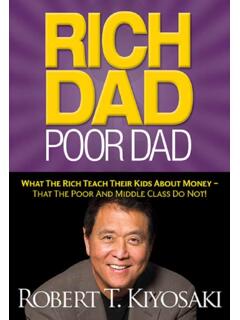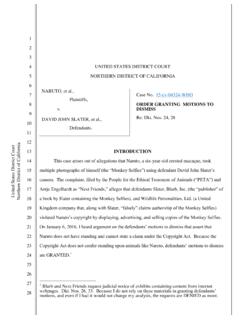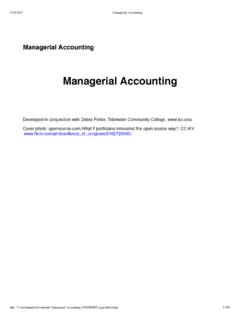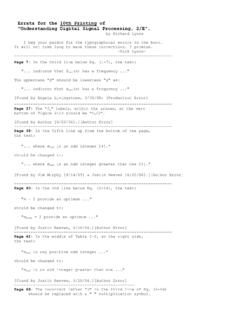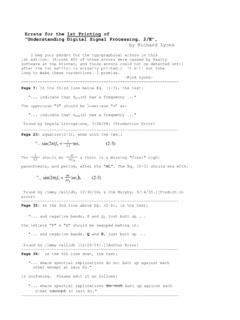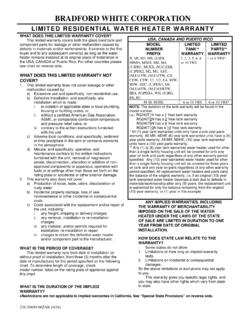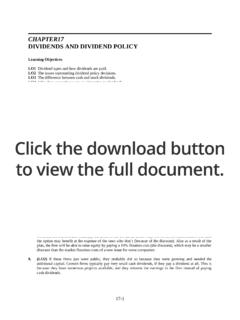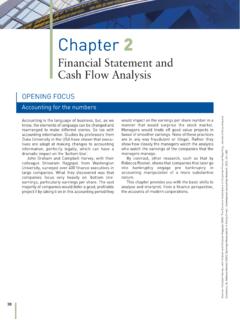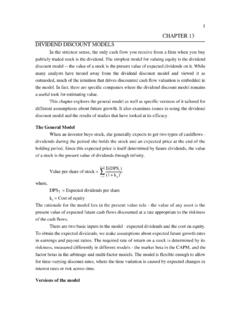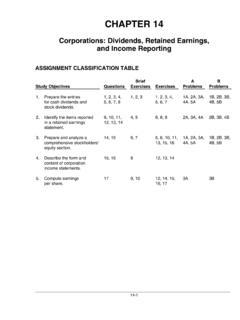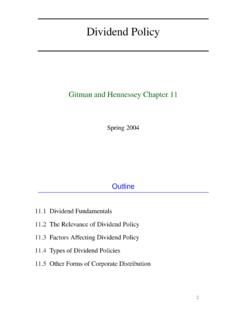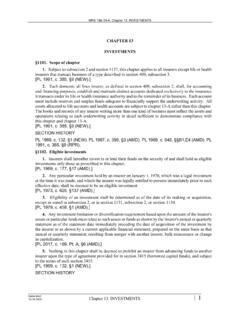Transcription of CHAPTER 15
1 CHAPTER 15. STOCKHOLDERS' EQUITY. IFRS questions are available at the end of this CHAPTER . TRUE-FALSE Conceptual Answer No. Description T 1. State a corporation incorporates in. F 2. Definition of preemptive right. T 3. Common stock as residual interest. F 4. Earned capital definition. T 5. Reporting true no-par stock. F 6. Allocating proceeds in lump sum sales. T 7. Accounting for stock issued for noncash consideration. F 8. Definition of treasury stock. F 9. Reporting treasury stock under cost method. T 10. Selling treasury stock below cost. F 11. Participating preferred stock. T 12. Callable preferred stock. T 13. Restricting legal capital. F 14.
2 Disclosing dividend policy . F 15. Affect of dividends on total stockholders' equity. T 16. Property dividends definition. T 17. Accounting for small stock dividend . F 18. Stock splits and large stock dividends. F 19. Computing rate of return on common stock equity. T 20. Computing payout ratio. MULTIPLE CHOICE Conceptual Answer No. Description c 21. Nature of stockholders' interest. b 22. Pre-emptive right. a 23. Pre-emptive right. S. b 24. Definition of legal capital. S. c 25. Definition of residual owner. c 26. Nature of stockholders' equity. d 27. Sources of stockholders' equity. d 28. Classification of stockholders' equity. d 29. Allocation methods for a lump sum issuance.
3 B 30. Capital stock issued in payment of services. a 31. Costs of issuing capital stock. b 32. Creation of "secret reserves.". P. a 33. Authorized shares. S. d 34. Par value stock. S. b 35. Legal restrictions for profit distributions. S. a 36. Acquisition of treasury shares. P. d 37. Treasury shares definition. 15 - 2 Test Bank for Intermediate Accounting, Thirteenth Edition c 38. Purchase of treasury stock at greater than par value. MULTIPLE CHOICE Conceptual (cont.). Answer No. Description a 39. Sale of treasury stock. a 40. Reissued treasury stock at less than acquisition cost. b 41. Reissued treasury stock at greater than acquisition cost.
4 C 42. Effect of treasury stock transactions. c 43. Preferred stock debt features. b 44. Cumulative feature of preferred stock. P. b 45. Reporting redeemable stock. S. c 46. Reporting dividends in arrears. c 47. Issued vs. outstanding common stock. b 48. Timing of entry to record dividends. c 49. Shares entitled to receive a cash dividend . c 50. Accounting for a property dividend . a 51. Distribution of a property dividend . a 52. Liquidating dividend . b 53. Entry to record a liquidating dividend . b 54. Effects of a stock dividend . b 55. Effects of a stock dividend . b 56. Effect of a large stock dividend . b 57. Large stock dividend . a 58. Small stock dividend .
5 A 59. Small stock dividend . b 60. Classification of stock dividends distributable. b 61. Effect of stock splits and stock dividends. c 62. Effect of a stock split. b 63. Disclosures in the balance sheet. a 64. Return on common stock equity calculation. b 65. Payout ratio calculation. c 66. Book value per share. P. a 67. Computing book value per share. c *68. Dividends and treasury stock. a *69. Noncumulative preferred stock and dividends in arrears. a *70. Disclosure of preferred dividends in arrears. P. These questions also appear in the Problem-Solving Survival Guide. S. These questions also appear in the Study Guide. *This topic is dealt with in an Appendix to the CHAPTER .
6 MULTIPLE CHOICE Computational Answer No. Description a 71. Composition of stockholders' equity. b 72. Calculation of total paid-in capital. b 73. Allocating proceeds in lump sum sales. c 74. Allocating proceeds in lump sum sales. d 75. Computing total paid-in capital. b 76. Allocating proceeds in lump sum sales. Stockholders' Equity 15 - 3. c 77. Allocating proceeds in lump sum sales. MULTIPLE CHOICE Computational (cont.). Answer No. Description d 78. Computing paid-in capital from treasury stock transactions. d 79. Recording purchase of treasury stock. b 80. Reissue treasury stock above acquisition cost. c 81. Reissue treasury stock cost method.
7 C 82. Additional paid-in capital with treasury stock transactions. d 83. Calculation of additional paid-in capital. c 84. Calculation of additional paid-in capital. a 85. Total stockholders' equity with treasury stock transactions. c 86. Total stockholders' equity with treasury stock exchange. c 87. Calculate dividends for cumulative preferred shares. a 88. Calculate dividends for common shares. a 89. Calculate dividends for common shares. c 90. Reduction in retained earnings from property dividends. d 91. Reduction in retained earnings from property dividends. b 92. Reduction in retained earnings caused by a property dividend . d 93. Reduction in retained earnings from property dividends.
8 D 94. Reduction in retained earnings from property dividends. a 95. Decrease in retained earnings from cash and stock dividends. c 96. Calculation of a large stock dividend . a 97. Calculation of a small stock dividend . b 98. Calculation of a small stock dividend . b 99. Small stock dividend 's effect on retained earnings. b 100. Balance of retained earnings after a small stock dividend . a 101. Calculate retained earnings available for dividends. a 102. Calculate decrease in retained earnings. c 103. Calculate the payout ratio. a 104. Calculate book value per share. d 105. Use same descrip. as 101. d 106. Use same descrip. as 102. c 107. Calculate rate of return on common stock equity.
9 C 108. Calculate price-earnings ratio. a 109. Calculate dividends paid to common stockholders. b 110. Rate of return on common stock equity. c 111. Determine the rate of return on common stock equity. a 112. Determine book value per share. b 113. Computation of payout ratio. b 114. Computation of book value per share. b *115. Allocation of cash dividend to common and preferred shares. d *116. Cash dividends for cumulative preferred shares. b *117. Cash dividends for cumulative participating preferred shares. c *118. Cash dividend allocation with participating preferred shares. b *119. Cash dividend for cumulative preferred shares. 15 - 4 Test Bank for Intermediate Accounting, Thirteenth Edition MULTIPLE CHOICE CPA Adapted Answer No.
10 Description d 120. Capital stock issued in payment of services. b 121. Proceeds from preferred stock in lump sum issue. c 122. Determine paid-in capital from treasury stock. b 123. Reissue treasury stock cost method. c 124. Effect of the reissuance of treasury stock. d 125. Entry to record property dividends declared. b 126. Effect of a liquidating dividend . d 127. Effect of a stock dividend . d 128. Stock dividend when market price exceeds par value. a 129. Balance of retained earnings following stock dividend . c *130. Allocation of cash dividend to common and preferred shares. EXERCISES. Item Description E15-131 Lump sum issuance of stock. E15-132 Treasury stock.

